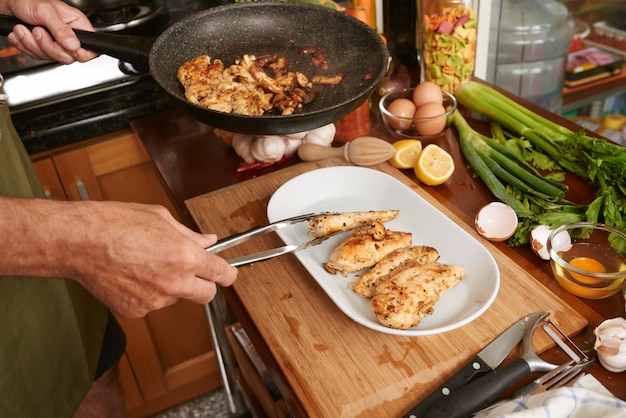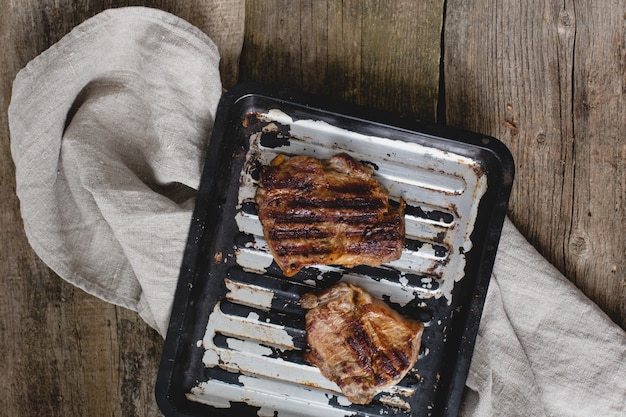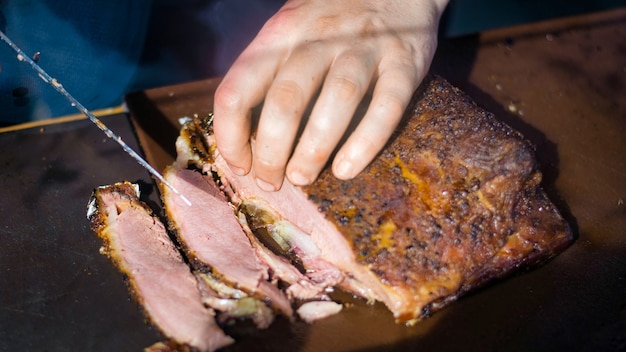(Part 1) A Bit About Pork Loin: Understanding Our Star Ingredient

Before we get into the details of roasting, let’s chat about pork loin itself. It's taken from the back of the pig and is usually boneless and lean. This leanness is great for those watching their waistlines, but it also means it can get a bit dry if you're not careful. We’re going to make sure that doesn’t happen, though!
Choosing the Right Pork Loin: Finding the Perfect Fit
The first thing you'll notice when choosing your pork loin is that it comes in a variety of sizes. If you’re cooking for one or two, you can grab a smaller, individual-sized loin. But for a crowd, you'll need to go bigger. Don't be shy about asking your butcher for advice – they're experts and can help you pick the perfect size for your needs.
Here’s a little tip from the pros: look for a pork loin with a pale pink color and a bit of marbling. That marbling adds flavor and moisture, making it more tender and juicy. Imagine the difference between a plain loaf of white bread and a sourdough; the marbling adds that extra "oomph!"
(Part 2) Seasoning the Pork Loin: A Symphony of Flavors

Alright, now onto the fun part! Seasoning is where you can really get creative with your pork loin. It’s a blank canvas waiting to be transformed into a delicious masterpiece. You can keep it simple with salt and pepper, or get adventurous with a mix of herbs, spices, and citrus zest. It’s totally up to you!
I personally love a simple rub with a blend of garlic powder, onion powder, smoked paprika, and a pinch of cayenne pepper. It gives the pork loin a lovely smoky flavor, a bit of heat, and a touch of sweetness. But hey, this is your masterpiece – experiment and find your perfect combination!
Don’t Forget the Fat: Adding Moisture and Flavor
Remember that leanness of pork loin? Well, to ensure it stays juicy, we’re going to add a layer of fat. A thin layer of bacon, for example, works wonders. It renders as it cooks, basting the pork loin and locking in moisture. Think of it as an insurance policy for a delicious, juicy roast. You can also try a thin layer of pancetta, or even some butter.
Brining: An Extra Boost of Flavor and Tenderness
If you're feeling ambitious, give brining a try! It’s a simple technique that involves soaking the pork loin in a salt-water solution for a few hours. This helps to season the meat, add moisture, and create a more tender texture. Think of it as giving your pork loin a little spa treatment before it goes into the oven!
For a basic brine, mix together water, salt, and sugar. Then, you can add herbs, spices, or even citrus zest to customize it to your liking. Make sure you choose a container that’s big enough to fully submerge the pork loin, and let it soak for at least 2-4 hours, or even overnight in the fridge. The longer it soaks, the more flavour and moisture it absorbs.
(Part 3) Pre-heating the Oven: Setting the Stage for a Delicious Roast

We’re getting into the nitty-gritty now, and pre-heating your oven is crucial for a successful roast. It’s like warming up your car engine before you hit the road – you want that oven nice and hot to create the perfect cooking environment.
For a pork loin roast, we’re aiming for 400 degrees Fahrenheit. This temperature helps to brown the outside of the pork loin while keeping the inside nice and moist. So, pre-heat your oven to 400 degrees and let it heat up for 10-15 minutes to ensure it's nice and consistent throughout.
(Part 4) Roasting the Pork Loin: Timing is Key
Now, let's talk about the main event – roasting the pork loin! It’s simple, but there are a few key things to keep in mind.
Cooking Time: A General Guideline for a Delicious Roast
Every oven is a little different, and so is every pork loin. A good general guideline for cooking time is around 20-30 minutes per pound. So, if you’ve got a 3-pound pork loin, you’re looking at about 60-90 minutes. But this is just a starting point – you’ll be using a meat thermometer to ensure it’s perfectly cooked.
Maintaining Even Heat: Balancing Time and Temperature
It’s important to maintain that 400 degrees Fahrenheit throughout the roasting time. You want to create a consistent heat environment so your pork loin cooks evenly. It’s a balancing act, really. You need to give the pork loin enough time to cook through, but you don't want to overcook it and end up with a dry, tough piece of meat.
Resting: The Key to Juicy, Flavorful Pork
Once your pork loin is cooked, don't rush to slice and serve it. Let it rest for 10-15 minutes before you dig in. It’s like giving it a chance to catch its breath after a workout. This resting time allows the juices to redistribute throughout the meat, making it even juicier and more flavorful. Trust me, it's worth the wait!
(Part 5) internal temperature: The Secret to a Perfectly Cooked Pork Loin
Here’s where the meat thermometer becomes your best friend! It's the key to ensuring a perfectly cooked pork loin. No more guesswork, no more worries!
The Safe Zone: 145 Degrees Fahrenheit
According to the USDA, the safe internal temperature for pork is 145 degrees Fahrenheit. It's like the finishing line for a race – you want to hit that temperature to ensure the pork is cooked through and safe to eat.
You have a few options for checking the internal temperature. You can use a traditional meat thermometer, the kind you insert into the meat. Or, go for a digital thermometer, which are really accurate and easy to use. There are even special probes that stay inside the meat and alert you when the desired temperature is reached – a great option for busy cooks!
Temperature Variance: The Role of Resting
Remember that resting period? It plays a role in internal temperature, too. As the pork loin rests, the internal temperature will continue to rise slightly. That's why it's important to check the temperature before it starts resting. You want to ensure it's reached at least 145 degrees Fahrenheit before you remove it from the oven. This way, it will continue to rise and hit the desired temperature as it rests.
(Part 6) Visual Clues: Reading the Signs of a Delicious Roast
While the meat thermometer is our go-to tool, there are some visual clues that tell you the pork loin is getting close to perfection. It's like reading the tea leaves, but for cooking!
The Color Change: A Sign of Browning
As the pork loin cooks, the surface will start to turn a beautiful golden brown. It’s a beautiful sight, just like watching a sunset. This browning indicates that the outside is getting crispy – a sign that it’s getting closer to being done.
The Juices: A Sign of Moisture and Doneness
You can also get an idea of doneness by observing the juices. When you poke the pork loin with a fork, the juices should run clear, not pink. It's like a little test to see if the meat is cooked through. If the juices are still pink, it needs a bit more time in the oven.
If you’re using a rack in your oven, check the bottom of the pan. You should see some fat rendering from the pork loin, which is a good sign that it's becoming tender and flavorful. It's a little reward for your patience!
(Part 7) Slicing and Serving: The Grand Finale
Alright, your pork loin has reached that magical 145 degrees Fahrenheit, it’s rested for 10-15 minutes, and now it’s time to slice and serve! It's like the big reveal at the end of a magic show – time to enjoy the fruits of your labor!
Slicing Tips: Getting It Just Right
Use a sharp chef’s knife for slicing – it’s like having a precision instrument in your hand! Slice the pork loin against the grain, meaning you're cutting perpendicular to the muscle fibers. This will make the meat more tender and easier to chew. You wouldn't want to try to cut through the grain – it would be like trying to cut through a rope!
Serving Suggestions: A World of Possibilities
You've got your perfectly cooked, sliced pork loin – now it’s time to get creative with the serving! It's like a blank canvas, ready to be painted with flavors.
Go classic with roasted vegetables and a simple gravy. Or, get adventurous with a fruity chutney or a tangy salsa. The possibilities are endless! And don’t forget about the sides. mashed potatoes, roasted potatoes, rice, or even a simple salad would all complement the pork loin beautifully.
Here’s a tip: I like to serve my pork loin with a pan sauce. You can make it by deglazing the pan with a little wine or broth and stirring in some butter and herbs. It’s a delicious way to add an extra layer of flavor.
(Part 8) FAQs: Common Pork Loin Queries
Now let's address some common questions that pop up when it comes to cooking pork loin – those things you’re thinking but might not want to ask!
1. Can I Overcook pork loin?
Absolutely! overcooked pork loin is dry, tough, and not very appealing. It’s like a sad little pancake, lacking the deliciousness of its prime. That’s why using a meat thermometer and checking the internal temperature is so important. It's the only way to ensure it’s cooked through but not overdone.
2. What Happens if I Don’t Have a Meat Thermometer?
Don’t worry, you can still get a decent result without a meat thermometer. It requires a bit more intuition and careful observation. Remember those visual clues we talked about earlier – the color change, the juices, the fat rendering. These are all good indicators of doneness. But using a meat thermometer is definitely more reliable.
3. What Should I Do if My Pork Loin Is a Bit Undercooked?
Don't panic! If your pork loin is a bit undercooked, just put it back in the oven for a few more minutes. Check the internal temperature regularly and take it out once it reaches 145 degrees Fahrenheit.
4. Can I Freeze Pork Loin?
Yes, you can freeze pork loin! It’s a great way to have it on hand for busy nights. Just make sure to wrap it tightly in plastic wrap and then aluminum foil. You can freeze it for up to 3 months.
5. What Are Some Other Ways to Cook Pork Loin?
Pork loin is incredibly versatile. You can grill it, pan-fry it, or even cook it in a slow cooker. The possibilities are endless! Just make sure to adjust the cooking time and temperature accordingly.
(Part 9) Final Thoughts: The Joy of a Perfectly Cooked Pork Loin
There you have it! Your complete guide to cooking pork loin at 400 degrees Fahrenheit. It's a simple but delicious way to enjoy this versatile cut of meat. Remember, practice makes perfect, so don’t be afraid to experiment, try new things, and find your perfect pork loin recipe.
I hope this article has been helpful. If you have any questions or feedback, please don't hesitate to leave a comment below. Happy cooking!
(Part 10) A Helpful Table for Reference
Here's a table that summarizes the cooking times for pork loin based on weight. Remember, these are just guidelines, and it's always best to use a meat thermometer to ensure it's cooked to perfection.
| Weight (lbs) | Cooking Time (minutes) |
|---|---|
| 1-2 lbs | 20-30 minutes |
| 2-3 lbs | 30-40 minutes |
| 3-4 lbs | 40-50 minutes |
| 4-5 lbs | 50-60 minutes |
Everyone is watching

Prime Rib Roast Cooking Time Chart: Per Pound Guide
Cooking TipsPrime rib roast. Just the name conjures images of lavish dinners, crackling fires, and hearty laughter. It’s ...

How Long to Bake Potatoes in the Oven (Perfect Every Time)
Cooking TipsBaked potatoes are a staple in my kitchen. They're incredibly versatile, delicious, and surprisingly easy to m...

Perfect Rice Every Time: The Ultimate Guide to Cooking Rice
Cooking TipsAs a self-proclaimed foodie, I've always been a bit obsessed with rice. It's the foundation of countless cuisi...

The Ultimate Guide to Cooking Asparagus: Tips, Techniques, and Recipes
Cooking TipsAsparagus. The mere mention of this spring delicacy conjures up images of vibrant green spears, crisp and burs...

Ultimate Guide to Cooking the Perfect Thanksgiving Turkey
Cooking TipsThanksgiving. Just the word conjures up images of overflowing tables laden with delicious food, the scent of r...
